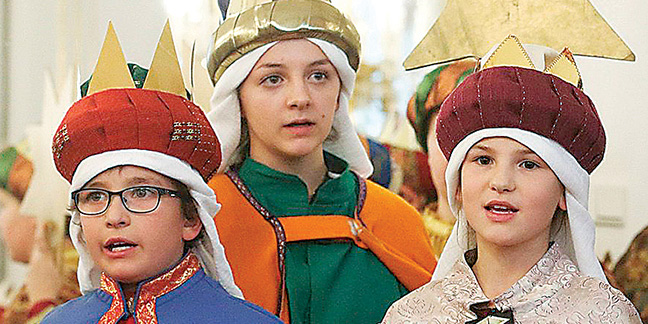 What would the Christmas season be without carols? These seasonal songs seem to greet us everywhere this time of year with their familiar melodies and lyrics. Though we may know the first verse and the refrain of a number of Christmas carols, do we know the origin of these songs?
What would the Christmas season be without carols? These seasonal songs seem to greet us everywhere this time of year with their familiar melodies and lyrics. Though we may know the first verse and the refrain of a number of Christmas carols, do we know the origin of these songs?
The singing of psalms in worship dates to earliest Christian times, a tradition with roots in Jewish religious custom. Hymns written in honor of Christ’s birth first appeared in the early centuries, such as “Of the Father’s Love Begotten,” composed by the Latin poet Aurelius Clemens Prudentius (348-413).
Over time, the repertoire of Latin chant that developed for use in the Mass came to include propers written for the Nativity and nearby celebrations on the Church calendar. Their words were based on Scripture and other sacred texts.
The kind of popular song we would call a “Christmas carol” today, however, had different origins. The word “carol” probably comes from the French “carole,” a circle dance accompanied by singing.
Up through the later Middle Ages, “caroles” were typically dance music. Eventually they were used as processional songs during religious festivals. Only later did they come to be sung in churches.
The singing of popular Christmas tunes received a boost from St. Francis of Assisi. In 1223 he formed a living Nativity scene, inviting the children to come see the crèche while he taught them simple songs to honor the coming of the Lord.
This new tradition spread throughout Europe, with each culture adding its own customs. Carols were learned by common folk. To the chagrin of some local parish priests, many of these new
Christmas carols borrowed melodies from well-known drinking songs. Clergy in some places opposed their being sung.
But the joy of singing carols was infectious and unstoppable. Bands of traveling musicians – carolers, as they would come to be known – performed on street corners, in taverns and in homes.
After the Protestant Reformation, Lutherans followed the lead of their founder, who encouraged his congregations to sing the popular songs. But the 17th-century English Puritans outlawed the singing of Christmas carols.
After Puritans fell from power, several 18th-century Anglican composers produced joyous hymns like “Joy to the World”, “O Come, All Ye Faithful” and “Hark! The Herald Angels Sing.”
Christmas carols experienced a renaissance during the 19th century.
Some of the most familiar carols we sing today were composed at that time, such as “Silent Night,” “Away in a Manger,” “O Little Town of Bethlehem,” “It Came Upon a Midnight Clear,” “Sleep, Holy Babe,” “We Three Kings of Orient Are” and “What Child Is This” (using an old English melody, “Greensleeves”).
When the English Queen Victoria married her cousin Prince Albert of Germany in 1840, it became known that the royal couple was quite fond of Christmas carols. In an attempt to gain royal favor, numerous families and church groups came to the royal palace to sing for them.
Like the troubadours of past centuries, these English carolers of the Victorian age took to the streets of London with their songs.
In the United States, caroling groups brought joy to the sick and the home bound. These days caroling groups have been replaced by recorded music. Yet the sight of a group of carolers still brings the season to life and is a reminder of the true meaning of the celebration.
— OSV News
The Christmas Eve creation of ‘Silent Night’
Father Josef Mohr (1792-1848) was the pastor of St. Nicholas Catholic Church in Oberndorf, Austria. In 1816 he composed the six verse lyrics to “Silent Night,” which would become one of the most popular Christmas carols of all time.
On Christmas Eve 1818 he presented the poem to the parish organist, Franz Xavier Gruber, with the request for Gruber to compose an appropriate melody for two solo voices with choir and guitar accompaniment. The carol was first performed during Mass that Christmas Eve.
Gruber sang bass as the church choir sang the refrains of each verse. Father Mohr played the guitar. The tune was warmly received by those who heard it that first night.
Father Mohr died in 1848. Before his death, the composer of “Silent Night” is reported to have said that his composing of the Christmas carol was one of the “most treasured moments” of his life.
Today a memorial chapel (the Silent Night Chapel) stands at the place where this famous song
was composed.


